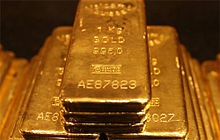December ECB Meeting And Gold
 Yesterday, the European Central Bank cut interest rates and extended its asset-purchase program. What does it mean for the gold market?
Yesterday, the European Central Bank cut interest rates and extended its asset-purchase program. What does it mean for the gold market?
The ECB meeting is behind us. What is the most important news? First, the ECB decided to lower the interest rate on the deposit facility by 10 basis points to -0.30 percent. Therefore, the ECB bravely entered deeper into the magic world of negative interest rates. The reduction in the deposit facility rate will not significantly affect the Eurozone’s economy, but it will reduce the euro exchange rate against the U.S. dollar. Thus, this is not good news for the gold market, as the price of gold is negatively correlated with the greenback.
Second, the ECB decided to extend the asset-purchase program until the end of March 2017 or beyond if necessary to achieve its inflation target (Draghi had previously planned to end the program in September 2016). The ECB will also reinvest the principal payments on the securities purchased under its asset-purchase program and include purchases of municipal bonds in the program.
Interestingly, the measures undertaken by Draghi did not live up to expectations and disappointed markets expecting more dovish actions. Investors are apparently spoiled if further negative interest rates and extended quantitative easing (temporarily and qualitatively) were considered nothing to get excited about. It seems that markets had expected that the asset-purchase program would be expanded, not only extended, but the ECB will continue to buy €60bn of assets on a monthly basis. This is why the euro rallied after the press conference – the ECB was dovish, but not as dovish as expected. Gold prices also increased due to the positive correlation with the euro (or the negative correlation with the U.S. dollar). This was a classic “sell the rumor, buy the fact” scenario for the euro and the yellow metal.
The key takeaway is that the ECB cut its deposit interest rate and extended its asset-purchase program. However, Draghi did not expand the pace of buying and, thus, disappointed investors addicted to easing who had expected more decisive actions. Therefore, the ECB meeting was positive for the gold market, but only initially, since less expansionary monetary policy gives the Fed more room to tighten its monetary conditions. Thus, a Fed hike in December is more likely after the ECB meeting turned out less dovish than expected. This is bad news for the gold market.
If you enjoyed the above analysis, we invite you to check out our other services dedicated to the precious metals investors. We invite you to join our gold newsletter today - you’ll also gain 7-day trial of our premium Gold & Silver Trading Alerts. It’s free and if you don’t like it, you can easily unsubscribe.
Arkadiusz Sieron
Sunshine Profits‘ Gold News Monitor and Market Overview Editor















